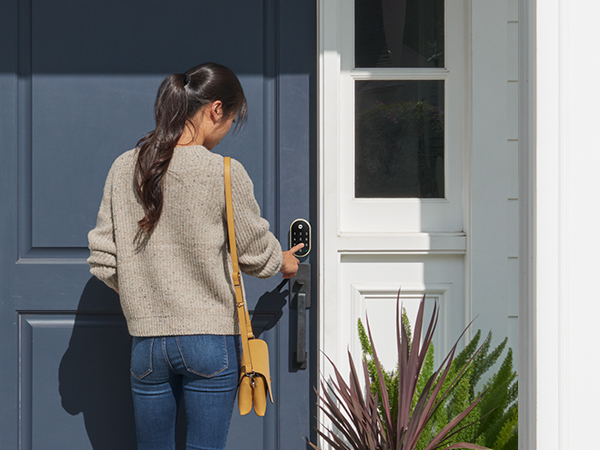
It's important to choose between home andaway mode when you are choosing a home security system. You want a security mode that allows you to still control the alarm sounding.
Simplisafe has three modes that you can set in the app: Away, which will arm all the sensors in the system; Home, which will disarm most of them; and Off, which won't arm any of the sensors at all. Whichever mode you choose, the system will behave differently.
How to Install the System
SimpliSafe systems consist of a basestation and a wireless keyboard that are mounted near the front door. The basestation is similar to a router and has a backup battery so that it can continue to function even if the power goes out.

You can add devices like cameras or motion detectors to your security system on a 'la carte' basis. The company has packages that cover a wide range of homes, from tiny apartments to large estates.
How to set the alarm away
When the alarm is triggered, a siren goes off at the base station and you get a phone call from the SimpliSafe monitoring center. If neither you nor your primary contact answer the call or say a word of safety, the monitoring station will send the police.
This feature can be helpful in situations where you might not be able to speak due to medical conditions or if someone's trying to scare you. This is a great option for tense situations where you don't want to reveal your safety code to the monitoring centre or say something wrong.
How to Tell the Difference between Home and Away
The first step in setting up your system is to name all of the sensors that you'd like to monitor. The keypad of the system will provide suggestions, but you can type each sensor's names yourself.

Once you've named all your sensors, they can be paired with the system's keypad and base station by pressing a small button on each. Sensors should be placed so they can detect motion at doors and windows.
How to Customize your System
Next, create a SimpliSafe account. Log in with your email address. You can change your password here and create additional accounts for guests or family members. You can also set a biometric password based on your voice, face, or iris.
SimpliSafe App: How to use it
The SimpliSafe mobile app is a good way to keep track of your system and check up on your home from anywhere with an internet connection. It's simple to setup and comes with a number other useful features. These include the ability disarm your system via the app when you're not home or to check up on your kids when they're home.
FAQ
Which is better: home security cameras or home security systems?
Home security systems are more effective than home security cameras because they can detect sounds and movement, even if no one is present in the room where the system is installed. Home security cameras, on the other hand, are more affordable than home security systems and can be easily mounted on windows or doors.
What is the most trusted home security system available?
The number one home security system is the Ring Video Doorbell Pro. It allows you to see and speak to anyone at anytime from anywhere using your smartphone. You can also record video footage, and then share it with your family and friends via email or text message.
Are there any real reasons to have a home alarm system?
If you own a home, you definitely need a home security system. Anytime, a burglar can break into your home without warning. They will take everything they want, even expensive jewelry. They can even take everything if your doors are unlocked.
Your home is protected by a home security system that alerts you to any potential dangers. This includes detecting motion, sending alerts to your mobile device, recording activity, and allowing you to view recorded footage.
You don't have to invest in a sophisticated home security system if you prefer not to. A simple DIY camera will do the trick. These devices allow you to see who's at your front door, and will send you notifications when they enter. These devices will not help stop intruders entering your home.
Statistics
- Cove sets you free without punishing penalties and fees, unlike other security solutions that charge 75% to 100% of your remaining contract. (safewise.com)
- Unlike other online safety services that charge up to 100 percent of your monthly fee, Cove charges no upfront fees and has no hidden costs.
- Most home security companies will charge you around 75% of the remaining term of your contract if you cancel early—and some require 100%.Related questionsWhat type of contract length can I expect from security providers?Home security system cancellation (safewise.com)
- Most home security companies will charge you around 75% of the remaining term of your contract if you cancel early—and some require 100%.Related questionsWhat type of contract length can I expect from security providers?Home security system cancellation (safewise.com)
External Links
How To
How to Install A Home Security System
A home security camera is a device that monitors your house and alerts you when there's activity. It could be a motion sensor, doorbell camera, smoke detector, fire alarm, flood alert, carbon monoxide detector, burglar alarm, etc. A home security package usually includes one or more sensors (e.g. a motion detector), which send signals whenever they detect sound or movement. The signals are then sent out to a control board where they can monitored and recorded. The control panel will send an alert to your smartphone, tablet, computer or voice assistant if there is a problem, such as someone breaking into your home. The control panel will notify you immediately so that you can take corrective action.
The first step to installing a home security system is choosing the right type of sensors for your home. There are two main types of sensors: passive and active. Passive sensors aren't powered by batteries. They just detect sounds and vibrations in their environment. These include buzzers, sirens and doorbells. Active sensors transmit data using electricity. These sensors include motion sensors and cameras.
There are many different brands of sensors available today. Each brand has its pros and cons. For instance, some sensors can be weatherproof while others don't. Some include built-in speakers to allow you hear them even when they are outside. Others work only inside. Some are basic while others offer advanced features, such as night vision.
After choosing the best sensor type for your property you can choose a manufacturer. This will ensure that all your sensors work together. You will find many options in your local hardware store.
After choosing a brand of sensors to use, you can decide how many to purchase. Depending upon whether they live alone or in a group, most people begin with one or two sensors. If you are planning to add sensors later on, you may consider purchasing additional sensors.
Next, consider where you want to put your sensors. Are you looking for them to be near doors or windows? Do you prefer to keep them away? Before placing them around your property, you should get permission. You should also ensure that they don't interfere with electrical outlets or other property features.
Once you have determined where your sensors should be placed, you will need to find a way to connect them with your control panel. You may need a power adapter, or battery pack depending on the setup. Once everything is setup, you will be able to monitor your property.